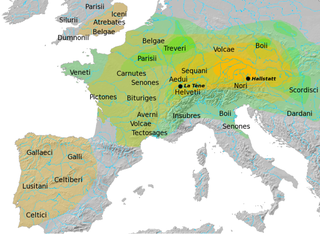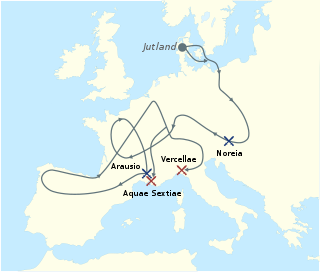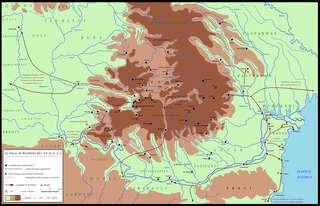Related Research Articles

The Boii were a Celtic tribe of the later Iron Age, attested at various times in Cisalpine Gaul, Pannonia, present-day Bavaria, in and around present-day Bohemia, parts of present-day Slovakia and Poland, and Gallia Narbonensis.

The Celts or Celtic peoples were a collection of Indo-European peoples in Europe and Anatolia, identified by their use of Celtic languages and other cultural similarities. Major Celtic groups included the Gauls; the Celtiberians and Gallaeci of Iberia; the Britons, Picts, and Gaels of Britain and Ireland; the Boii; and the Galatians. The relation between ethnicity, language and culture in the Celtic world is unclear and debated; for example over the ways in which the Iron Age people of Britain and Ireland should be called Celts. In current scholarship, 'Celt' primarily refers to 'speakers of Celtic languages' rather than to a single ethnic group.

Galatia was an ancient area in the highlands of central Anatolia, roughly corresponding to the provinces of Ankara and Eskişehir, in modern Turkey. Galatia was named after the Gauls from Thrace, who settled here and became a small transient foreign tribe in the 3rd century BC, following the Gallic invasion of the Balkans in 279 BC. It has been called the "Gallia" of the East.

The Marcomanni were a tribe that established a powerful kingdom north of the Danube, somewhere near modern Bohemia, during the peak of power of the nearby Roman Empire. According to Tacitus and Strabo, they were Suebian.

Pannonia was a province of the Roman Empire bounded on the north and east by the Danube, coterminous westward with Noricum and upper Italy, and southward with Dalmatia and upper Moesia. Pannonia was located in the territory that is now western Hungary, western Slovakia, eastern Austria, northern Croatia, north-western Serbia, northern Slovenia, and northern Bosnia and Herzegovina.

The Dacians were the ancient Indo-European inhabitants of the cultural region of Dacia, located in the area near the Carpathian Mountains and west of the Black Sea. They are often considered a subgroup of the Thracians. This area includes mainly the present-day countries of Romania and Moldova, as well as parts of Ukraine, Eastern Serbia, Northern Bulgaria, Slovakia, Hungary and Southern Poland. The Dacians and the related Getae spoke the Dacian language, which has a debated relationship with the neighbouring Thracian language and may be a subgroup of it. Dacians were somewhat culturally influenced by the neighbouring Scythians and by the Celtic invaders of the 4th century BC.

Komárno, colloquially also called Révkomárom, Öregkomárom, Észak-Komárom in Hungarian, is a town in Slovakia at the confluence of the Danube and the Váh rivers. Historically it was formed by the "old town" on the left bank of Danube, present day Komárno in Slovakia, and by a "new town" on the right bank, present day Komárom in Hungary, which were historically one administrative unit. Following World War I and the Treaty of Trianon, the border of the newly created Czechoslovakia cut the historical, unified town in half, creating two new independent towns in two countries. Komárno and Komárom are connected by the Elisabeth Bridge, which used to be an official border crossing between Slovakia and Hungary until border checks were lifted due to the Schengen Area rules. In 2020, a new road bridge was opened.

Isaccea is a small town in Tulcea County, in Northern Dobruja, Romania, on the right bank of the Danube, 35 km north-west of Tulcea. According to the 2021 census, it has a population of 4,408.

The Scordisci were an Iron Age cultural group who emerged after the Celtic settlement of Southeast Europe, and who were centered in the territory of present-day Serbia, at the confluence of the Savus (Sava), Dravus (Drava), Margus (Morava) and Danube rivers. They were historically notable from the beginning of the third century BC until the turn of the common era, and consolidated into a tribal state. At their zenith, their core territory stretched over regions comprising parts of present-day Serbia, Croatia, Bulgaria and Romania, while their influence spread even further. After the Roman conquest in the 1st century AD, their territories were included into the Roman provinces of Pannonia, Moesia and Dacia.

Devín is a borough of Bratislava, the capital of Slovakia, located in the Bratislava IV district. Originally a separate village at the confluence of the Danube and Morava rivers, Devín maintained its rural character and today, it is one of the smallest boroughs of Bratislava by population. It is an important archaeological site, featuring the ruins of Devín Castle.

The Cimbrian or Cimbric War was fought between the Roman Republic and the Germanic and Celtic tribes of the Cimbri and the Teutons, Ambrones and Tigurini, who migrated from the Jutland peninsula into Roman-controlled territory, and clashed with Rome and her allies. The Cimbrian War was the first time since the Second Punic War that Italia and Rome itself had been seriously threatened.
The various names used since classical times for the people known today as the Celts are of disparate origins.
Celticisation, or Celticization, was historically the process of conquering and assimilating by the ancient Celts, or via cultural exchange driven by proximity and trade. Today, as the Celtic inhabited-areas significantly differ, the term still refers to making something Celtic, usually focusing around the Celtic nations and their languages.

Gallic groups, originating from the various La Tène chiefdoms, began a southeastern movement into the Balkans from the 4th century BC. Although Gallic settlements were concentrated in the western half of the Carpathian basin, there were notable incursions and settlements within the Balkans.

The Danube is the second-longest river in Europe, after the Volga in Russia. It flows through Central and Southeastern Europe, from the Black Forest south into the Black Sea. A large and historically important river, it was once a frontier of the Roman Empire. In the 21st century, it connects ten European countries, running through their territories or marking a border. Originating in Germany, the Danube flows southeast for 2,850 km (1,770 mi), passing through or bordering Austria, Slovakia, Hungary, Croatia, Serbia, Romania, Bulgaria, Moldova, and Ukraine. Among the many cities on the river are four national capitals: Vienna, Bratislava, Budapest, and Belgrade. Its drainage basin amounts to 817,000 km2 (315,000 sq mi) and extends into nine more countries.

Teurisci was a Dacian tribe at the time of Ptolemy. They were originally considered a branch of the Celtic Taurisci (Noricum), who moved to Upper Tisza. However, the archaeology shows that Celts have been absorbed by Dacians, at some point creating a Celto-Dacian cultural horizon in the upper Tisza.

The appearance of Celts in Western Romania can be traced to the later La Tène period . Excavation of the great La Tène necropolis at Apahida, Cluj County, by S. Kovacs at the turn of the 20th century revealed the first evidence of Celtic culture in Romania. The 3rd–2nd century BC site is remarkable for its cremation burials and chiefly wheel-made funeral vessels.
References
- ↑ The Ancient Celts by Barry Cunliffe, ISBN 0-14-025422-6, 2000, page 86: "... distinguished suggests that one of the returning groups, led by Bathanatos, finally settled in the Middle Danube region at the confluence ..."
- ↑ Celts - a History, The by Daithi O HOgain, ISBN 1-905172-20-6, 2006, page 60: "... those who, on their return from Greece under their leader Bathanatos, had settled at the confluence of the Danube and the ..."